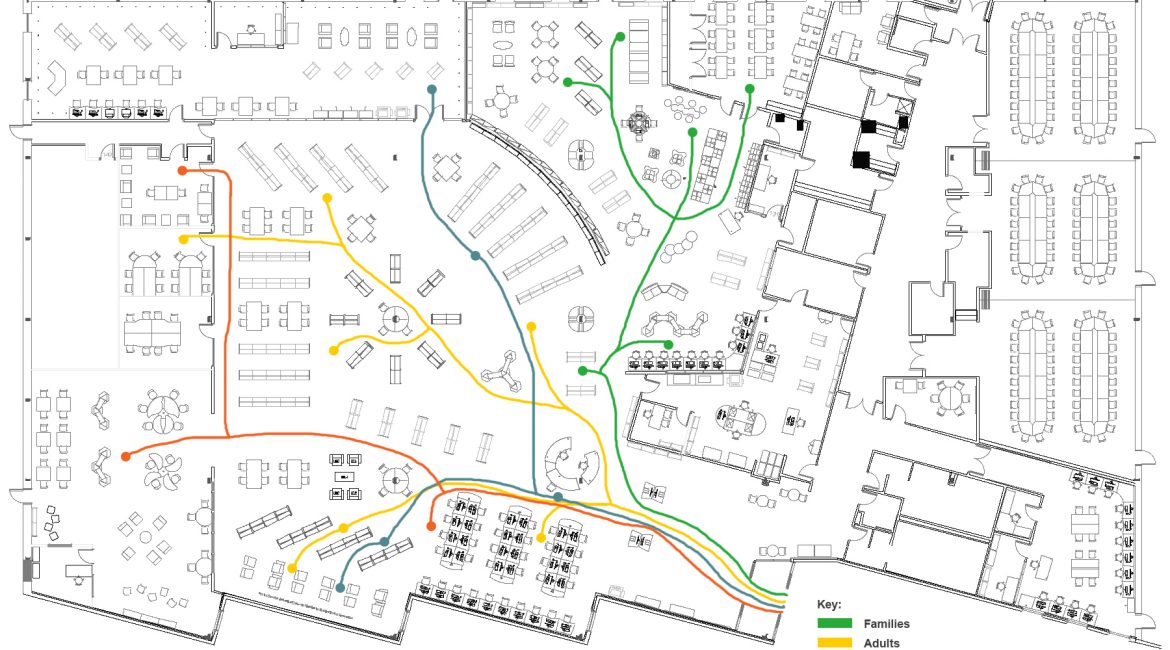This article first introduces the background and purpose of Wayfinding Signage, and then outlines its various applications in interior spaces. Next, application cases of Wayfinding Signage in hotel lobbies, hospitals, exhibition halls and shopping malls are discussed in detail.
Finally, the chapter summarizes the strengths and challenges of Wayfinding Signage and makes some suggestions for improvement and optimization.
In the following chapters, the specific design and effectiveness evaluation methods for each application area will be explored in depth separately. Through this structural arrangement, this paper aims to comprehensively and systematically study the application of Wayfinding Signage in interior spaces.
Chapter 1 Introduction
1.1 Background and Purpose
In today’s busy city life, people often need to travel to various indoor venues such as hotels, hospitals, exhibition halls and shopping centers. However, these venues usually have complex indoor structures, making it easy for people to get lost in them. To solve this problem, Wayfinding Signage is widely used for navigation in indoor spaces.Wayfinding Signage is an important navigational tool that helps people find the right path and destination in complex indoor environments such as large buildings, airports, and shopping centers. This study aims to explore the application of Wayfinding Signage in indoor spaces and analyze its advantages and challenges.
1.2 Significance of the study
With the acceleration of urbanization and the increase of population density, the problem of navigation in indoor spaces becomes more and more important. Getting lost and failing to find destinations are common problems, which not only cause inconvenience, but also may lead to time wastage and psychological pressure. Therefore, an effective Wayfinding Signage system is essential to improve the navigation efficiency and user experience in indoor spaces.
In addition, with the development of technology, traditional paper-based guide signs are gradually replaced by digital Wayfinding Signage. Digital Wayfinding Signage has more functions and advantages, such as updating information in real time, providing personalized navigation, and enhancing user experience. Therefore, it is of great significance to study the application of Wayfinding Signage in indoor space to promote the development of digital navigation technology.
Chapter 2 Wayfinding Signage Overview
2.1 Definition and Function
Wayfinding Signage is a signage system used to guide people in navigating through indoor spaces. It helps people quickly find their desired location or goal by providing clear directions, pathfinding, and destination information.Wayfinding Signage typically uses visual symbols, text, arrows, graphics, and other elements to convey information to help people understand and follow navigation instructions.
Key features of Wayfinding Signage include:
- Providing navigational guidance: Wayfinding Signage can point people in the direction of different areas, floors, rooms or facilities to help them avoid getting lost and wasting time.
- Providing Destination Information: Wayfinding Signage can display the name, number or brief description of each location so that people know where they are and how to get there.
- Provide additional information: In addition to basic navigational guidance, Wayfinding Signage can provide other relevant information such as emergency exit directions, restroom locations, restaurant menus, etc. to enhance the user experience.
- Improve safety: By clearly indicating the location of safety exits, evacuation routes and emergency facilities, Wayfinding Signage can help people to evacuate quickly and safely in case of emergency.
2.2 History
The concept of Wayfinding Signage can be traced back to the 1950s, when it was mainly used in large transportation hubs such as airports and railway stations. With the acceleration of urbanization and the expansion of building scale, Wayfinding Signage began to be applied to more indoor places, such as shopping centers, hospitals, exhibition halls and so on.
With the support of digital technology, the design and implementation of Wayfinding Signage becomes more flexible and personalized. Traditional paper-based guide signs are gradually replaced by digital Wayfinding Signage, which can be presented through electronic screens, touch screens and other devices, and provide more interactive functions and services.
In recent years, with the popularity of smartphones and mobile applications, Wayfinding Signage has also begun to be integrated with mobile navigation systems for a more intelligent navigation experience. For example, users can obtain real-time navigation guidance and recommended routes through mobile apps without relying on paper signs.
2.3 Technical Principle
The technical principles of Wayfinding Signage include the following:
- Positioning technology: By using the Global Positioning System (GPS) or other positioning technologies, the user’s current location can be determined, and corresponding navigation guidance can be provided according to the user’s needs.
- Map Data: Wayfinding Signage requires the use of map data to determine relationships and distances between different locations. This data can be managed and updated through a Geographic Information System (GIS).
- Design and Layout: The design of Wayfinding Signage needs to take into account the visual habits and cognitive characteristics of the user to ensure that the information is clearly readable and easy to understand. In addition, the layout needs to be well planned to avoid crowding and confusion.
- Interactivity: Modern Wayfinding Signage is often characterized by interactivity, allowing interaction with the user through touch screens, voice recognition, and other means. This can provide a more personalized navigation experience and more accurate information feedback.
To summarize, Wayfinding Signage, as an important navigation tool, plays an important role in the application of indoor space. Through rational design and effective implementation, it can improve navigation efficiency, reduce the rate of getting lost, and provide people with a better indoor navigation experience.
Chapter 3 Navigational Challenges in Indoor Spaces
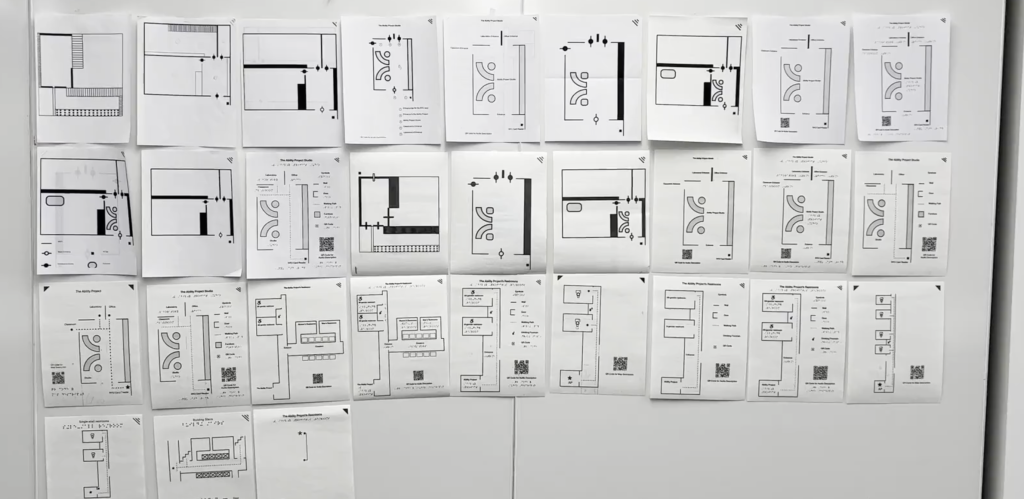
3.1 Complex indoor environments
Indoor spaces usually consist of multiple floors, corridors, rooms, and facilities, and these elements often intertwine with each other to form a complex maze-like structure. In such environments, people can easily get lost, especially in crowded places such as large buildings or shopping centers. In addition, indoor spaces may be affected by other factors such as poor lighting, crowded crowds, and noise interference, all of which increase the difficulty of navigation.
3.2 Heavy Pedestrian Traffic and Congestion
In busy indoor places, such as airports, railway stations, shopping centers, etc., dense pedestrian flow is a common problem. A large number of people gather together, making it necessary for people to traverse the congestion when looking for their destinations. This not only increases the difficulty of navigation, but also may lead to time wastage and psychological stress. Therefore, how to provide effective Wayfinding Signage in crowded environments becomes an important challenge.
3.3 Information Overload and Sense of Disorientation
In indoor spaces, people are often faced with a large amount of information and choices. For example, in a large shopping center, there are numerous stores, restaurants and entertainment facilities to choose from. In this situation, people may feel confused and disoriented as to where to go and how to get to the target location. In addition, with the development of technology, people can access more navigation information through mobile apps and electronic screens. However, too much information can also lead to information overload and a sense of disorientation, making it difficult for people to make the right decisions.
To address these challenges, the design of Wayfinding Signage needs to consider the following factors:
- Concise and clear information: Wayfinding Signage should provide clear and concise directional information, avoiding lengthy text and complex graphics. This will help people to quickly understand and recognize the navigational guidance within a limited visual range.
- Clear Signage: Wayfinding Signage should be highly visible and recognizable to ensure that the content of the signage can be easily identified from a distance. This can be achieved through the use of eye-catching colors, large fonts and bright lighting.
- Proper Layout: The layout of Wayfinding Signage should take into account the structure of the interior space and the distribution of foot traffic. It should have signs at key locations and frequently used paths to minimize the possibility of getting lost. The layout should also avoid creating congestion and confusion.
- Interactivity design: Modern Wayfinding Signage can utilize interactive technology to enhance the user experience. For example, personalized navigational guidance can be provided using touchscreen or voice recognition technology, or real-time location updates and recommended routes can be provided through mobile apps. Such interactive designs can provide a more convenient and accurate navigation experience.
In summary, navigation challenges in indoor spaces include complex indoor environments, heavy foot traffic and congestion, and information overload and disorientation. In order to address these challenges, the design of Wayfinding Signage needs to take into account factors such as concise and clear information, clear signage, reasonable layout and interactive design. By taking these factors into account, we can improve the efficiency and user experience of navigating indoor spaces.
Chapter 4 Wayfinding Signage in Hotel Lobbies
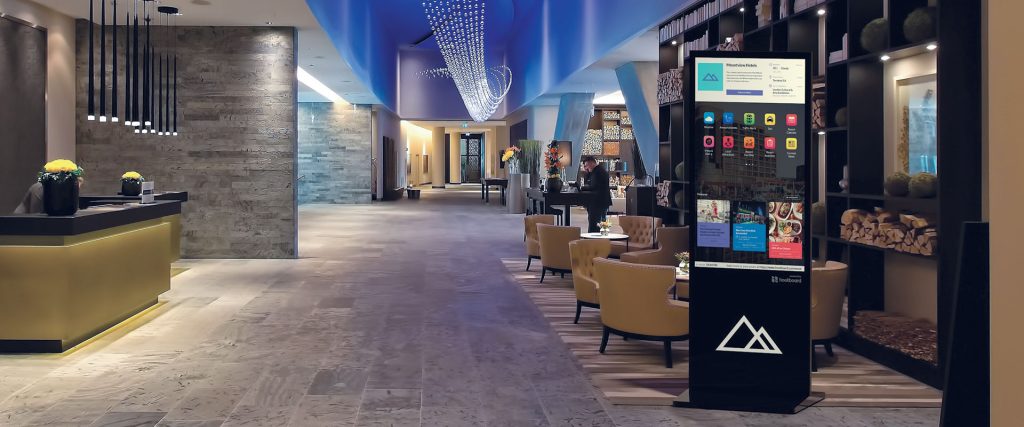
4.1 Importance and Challenges of Hotel Lobbies
The hotel lobby is the first impression of guests entering the hotel, and it is also an important place for them to check in and ask for information. Therefore, the navigation design of hotel lobbies is crucial to provide a good service experience. However, hotel lobbies usually have a large space and complex structure, as well as a dense flow of people, which brings some challenges to the design of Wayfinding Signage.
4.2 Design Highlights of Wayfinding Signage
In the hotel lobby, the design of Wayfinding Signage should consider the following points:
- Clear and concise instructions: Wayfinding Signage in a hotel lobby should provide clear and concise instructions to help guests quickly find the front desk, lounge area, restaurant, elevator and other important areas. Directions should use easy-to-read fonts and clear graphics to ensure that guests can easily understand and recognize them.
- Planning of guiding paths: Hotel lobbies usually have multiple entrances and exits, Wayfinding Signage should reasonably plan guiding paths to avoid guests getting lost or going in the wrong direction. This can be achieved by setting up clear signs, arrows and directional signs. At the same time, the continuity and logic of the guided path should be ensured so that guests can go to their destinations smoothly.
- Multi-language support: Considering that hotel lobbies may receive guests from different countries and cultures, Wayfinding Signage should provide multi-language support. This can be achieved by adding bilingual instructions to the signage or providing multilingual versions of maps, for example. Such support can help guests from different countries to better understand the navigation instructions.
- Security Considerations: Hotel lobbies often have high security requirements, and Wayfinding Signage should also take security considerations into account. For example, emergency exit indications can be installed in key areas and visible signs can be placed near escape routes. In addition, security can be improved by adding lighting and monitoring equipment.
4.3 Example Analysis: Wayfinding Signage Design for a Hotel Lobby
The lobby of a hotel is used as an example for the case study. The lobby of this hotel has a large area, including reception area, rest area, restaurant and other functional areas. In order to improve the navigation efficiency, the hotel has set up a series of Wayfinding Signage in the lobby. firstly, a large LED display is set up at the entrance to show the name of the hotel and the introduction of the main facilities. Secondly, hanging signage was installed on the main passageways in the lobby to indicate the directions and distances to various areas. In addition, signage on the handrail was installed at the stairway to guide guests to their destinations on each floor. Finally, several electronic screens were installed in the lobby to provide real-time room reservation information and directions. The design of these Wayfinding Signage enabled guests to quickly find the desired location and provided easy and accurate navigation guidance.
4.4 Evaluation and Suggestions for Improvement
In order to evaluate the effectiveness of Wayfinding Signage in hotel lobbies, the following aspects can be evaluated:
- User Satisfaction Survey: A questionnaire or interview with guests staying in the hotel to find out their satisfaction and feedback on the Wayfinding Signage design. This can provide important information about the user experience and directions for improvement.
- Error rate statistics: Record the error rate and usage of Wayfinding Signage instructions, such as the number of times they are ignored or misunderstood. This can help identify directions and priorities for improvement.
- User Behavior Analysis: By observing behavioral data such as guests’ walking paths and length of stay when using Wayfinding Signage, we can understand their reactions to and the effectiveness of the navigational guidance. This can provide a reference basis for further design optimization.
- User feedback collection: Encourage guests to actively provide feedback and suggestions on Wayfinding Signage. This can be accomplished by setting up suggestion boxes, online feedback forms, etc. Such feedback can help identify potential problems and provide opportunities for improvement.
Based on the results of the above assessment, suggestions for improvement can be made accordingly. For example, if it is found that some instructions are not clear and easy to understand, consideration can be given to redesigning or adding more explanations; if it is found that users often ignore or misunderstand some instructions, the user experience can be improved by adjusting the layout or adding additional signs; if it is found that users have a high demand for certain areas but lack corresponding navigation guidelines, corresponding signs and instructions can be added according to the actual situation, and so on.
To summarize, the application of Wayfinding Signage in hotel lobbies needs to consider factors such as clear instructions, reasonable guide path planning, multi-language support and security. By analyzing and evaluating the actual cases, we can improve the navigation efficiency and user experience in the hotel lobby.
Chapter 5 Wayfinding Signage in Airports
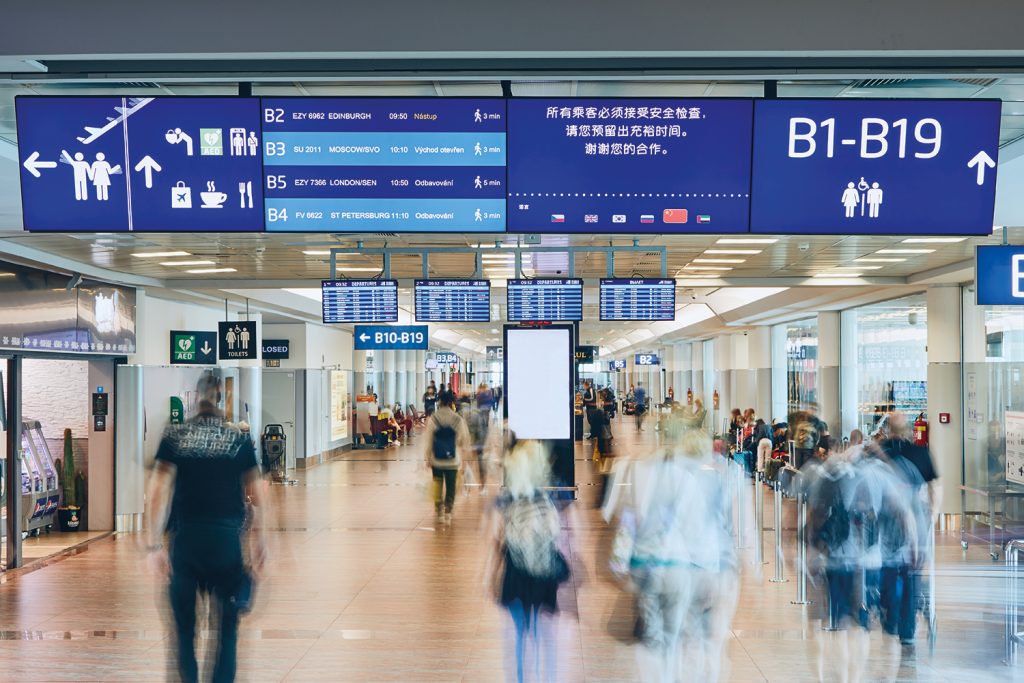
5.1 Importance and Challenges of Airports
As an important transportation hub, airports carry a large number of passengers and flights every day. Due to the large scale and complex structure of airports, as well as the dense flow of people, it brings many challenges to the design of Wayfinding Signage. Therefore, providing effective navigation guidance in airports is essential to improve passenger experience and reduce the rate of getting lost.
5.2 Design Elements of Wayfinding Signage
The following key points should be considered in the design of Wayfinding Signage in airports:
- Clear and concise directions: Airports usually have multiple terminals, gates, baggage claim areas, and other important areas, and Wayfinding Signage should provide clear and concise directions to help travelers quickly find where they need to go. Directions should use easy-to-read fonts and clear graphics to ensure that travelers can easily understand and recognize them.
- Planning of guided paths: Airports often have multiple access points and exits, and Wayfinding Signage should plan guided paths appropriately to avoid travelers getting lost or going in the wrong direction. This can be achieved by setting up clear signs, arrows and directional signs. At the same time, the continuity and logic of the guided paths should be ensured so that travelers can get to their destinations smoothly.
- Multi-language support: Considering that airports may receive travelers from different countries and cultures, Wayfinding Signage should provide multi-language support. This can be achieved by adding bilingual instructions to the signage or providing multilingual versions of maps, for example. Such support can help travelers from different countries to better understand the navigation instructions.
- Security Considerations: Airports often have high security requirements, and Wayfinding Signage should also take security considerations into account. For example, this can be done by having visible signs near emergency exits and providing clear instructions on escape routes. In addition, security can be improved by adding lighting and monitoring equipment.
5.3 Example Analysis: Wayfinding Signage Design for an Airport
An airport is used as an example for the case study. The airport is a large international hub airport with multiple terminals, runways, parking lots and other facilities. In order to improve the navigation efficiency, this airport has set up a series of Wayfinding Signage in the lobby, boarding gates, and baggage claim areas.First, a large LED display is set up at the entrance of the terminal building to show the name of the terminal and the introduction of the main facilities. Secondly, hanging signage was installed along the main corridors of the concourse to indicate the directions and distances to each area. In addition, signage on handrails was installed at the boarding gates to guide passengers to the boarding gates for each flight. Finally, electronic screens and information boards were installed in the baggage claim area to provide real-time flight information and baggage inquiry services. The design of these Wayfinding Signage enabled travelers to quickly find the desired location and provided easy and accurate navigation guidance.
5.4 Effectiveness Evaluation and Suggestions for Improvement
In order to evaluate the effectiveness of Wayfinding Signage in airports, the following aspects can be evaluated:
- User Satisfaction Survey: a questionnaire or interview with travelers to find out their satisfaction and feedback on the Wayfinding Signage design. This can provide important information about the user experience and directions for improvement.
- Error rate statistics: Record the error rate and usage of Wayfinding Signage instructions, such as the number of times they are ignored or misunderstood. This can help identify directions and priorities for improvement.
- User Behavior Analysis: By observing behavioral data such as travelers’ walking paths and length of stay when using Wayfinding Signage, it is possible to understand their reactions to and the effectiveness of the navigational guidance. This can provide a reference basis for further design optimization.
- User feedback collection: Encourage travelers to actively provide feedback and suggestions on Wayfinding Signage. This can be accomplished by setting up suggestion boxes, online feedback forms, etc. Such feedback can help identify potential problems and provide opportunities for improvement.
Based on the results of the above assessment, suggestions for improvement can be made accordingly. For example, if it is found that some instructions are not clear and easy to understand, consideration can be given to redesigning or adding more explanations; if it is found that users often ignore or misunderstand some instructions, the user experience can be improved by adjusting the layout or adding additional signs; if it is found that users have a high demand for certain areas but lack corresponding navigation guidelines, corresponding signs and instructions can be added according to the actual situation, and so on.
To summarize, the application of Wayfinding Signage in airports needs to consider factors such as clear instructions, reasonable guidance path planning, multi-language support and security. By analyzing and evaluating the actual cases, the navigation efficiency and user experience in airports can be improved.
Chapter 6 Wayfinding Signage in Shopping Malls
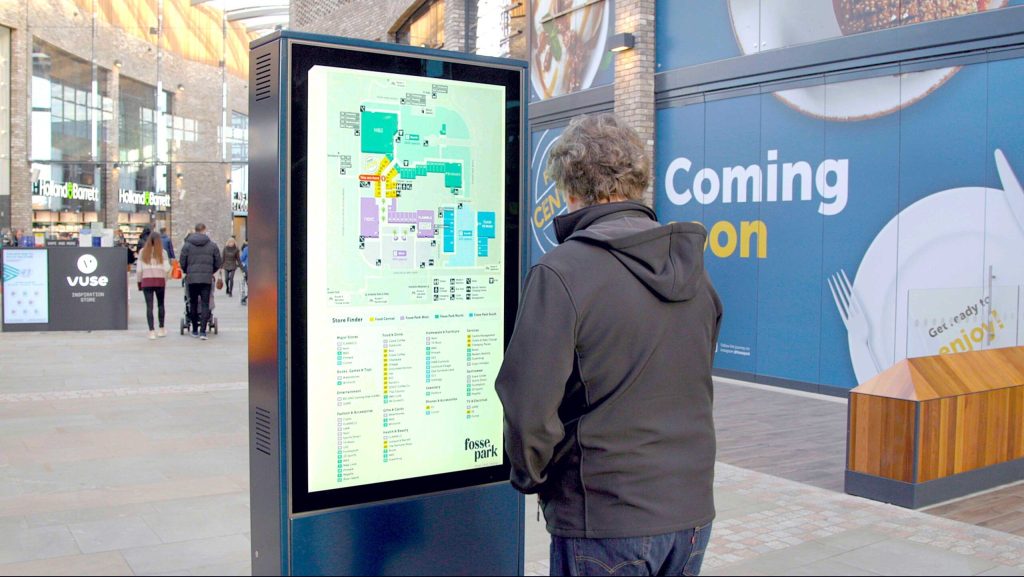
6.1 Importance and Challenges of Shopping Malls
Shopping malls, as a place for people to shop and have fun, usually have a huge space and complex structure.The presence of a large number of product categories, merchants and service facilities, as well as the high pedestrian flow in malls, brings many challenges to the design of Wayfinding Signage.Therefore, providing effective navigational guidance in shopping malls is essential to enhance customer experience and reduce the rate of getting lost.
6.2 Design Elements of Wayfinding Signage
The following key points should be considered in the design of Wayfinding Signage in shopping malls:
- Clear and concise directions: Shopping malls usually have multiple floors, store areas, public facilities and other important areas, Wayfinding Signage should provide clear and concise directions to help customers quickly find where they need to go.Signage should use easy-to-read fonts and clear graphics to ensure that customers can easily understand and recognize them.
- Planning of guiding paths: Shopping malls usually have multiple passages and corridors, and Wayfinding Signage should plan guiding paths appropriately to avoid customers getting lost or going in the wrong direction.This can be achieved by setting up clear signs, arrows and directional signs.At the same time, continuity and logic should be ensured so that customers can travel to their destinations smoothly.
- Multi-language support: Considering that the mall may receive customers from different countries and cultures, Wayfinding Signage should provide multi-language support.This can be achieved by adding bilingual instructions to the signage or providing multilingual versions of maps, for example.Such support can help customers from different countries to better understand the navigation instructions.
- Security Considerations: Shopping malls usually have high security requirements, and Wayfinding Signage should also take security considerations into account.For example, this can be done by having visible signs near emergency exits and providing clear instructions on escape routes.In addition, safety can be enhanced by adding lighting and monitoring equipment.
6.3 Example Analysis: Wayfinding Signage Design for a Shopping Mall
A shopping mall is used as an example for the case study.The mall is a large shopping center with multiple floors, stores, restaurants and entertainment facilities.In order to improve the navigation efficiency, a series of Wayfinding Signage are installed on each floor of the mall. firstly, a large LED display is installed at the entrance to show the main information and map of the mall.Secondly, hanging signage was installed on the main walkways to indicate the orientation of each floor and the location of stores.In addition, signage on handrails was installed at stairways to guide customers to their destinations on each floor.Finally, electronic screens and information boards were installed in the lobby to provide real-time product information and event notifications.The design of these Wayfinding Signage enabled customers to quickly locate their desired locations and provided easy and accurate navigational guidance.
6.4 Effectiveness Evaluation and Suggestions for Improvement
In order to evaluate the effectiveness of Wayfinding Signage in shopping malls, the following aspects can be evaluated:
- User Satisfaction Survey: A questionnaire or interview with customers to find out their satisfaction and feedback on the Wayfinding Signage design.This can provide important information about the user experience and directions for improvement.
- Error rate statistics: Record the error rate and usage of Wayfinding Signage instructions, such as the number of times they are ignored or misunderstood.This can help identify directions and priorities for improvement.
- User Behavior Analysis: By observing behavioral data such as customers’ walking paths and dwell time when using Wayfinding Signage, it is possible to understand their reactions to and the effectiveness of the navigational guidance.This can provide a reference basis for further design optimization.
- User feedback collection: Encourage customers to actively provide feedback and suggestions on Wayfinding Signage.This can be accomplished by setting up suggestion boxes, online feedback forms, etc.Such feedback can help identify potential problems and provide opportunities for improvement.
Based on the results of the above assessment, suggestions for improvement can be made accordingly.For example, if it is found that some instructions are not clear and easy to understand, consideration can be given to redesigning or adding more explanations; if it is found that users often ignore or misunderstand some instructions, the user experience can be improved by adjusting the layout or adding additional signs; if it is found that users have a high demand for certain areas but lack corresponding navigation guidelines, corresponding signs and instructions can be added according to the actual situation, and so on.
To summarize, the application of Wayfinding Signage in shopping malls needs to consider the factors of clear instructions, reasonable guide path planning, multi-language support and security.By analyzing and evaluating the actual cases, we can improve the navigation efficiency and user experience in shopping malls.
Chapter 7 Wayfinding Signage in Museums
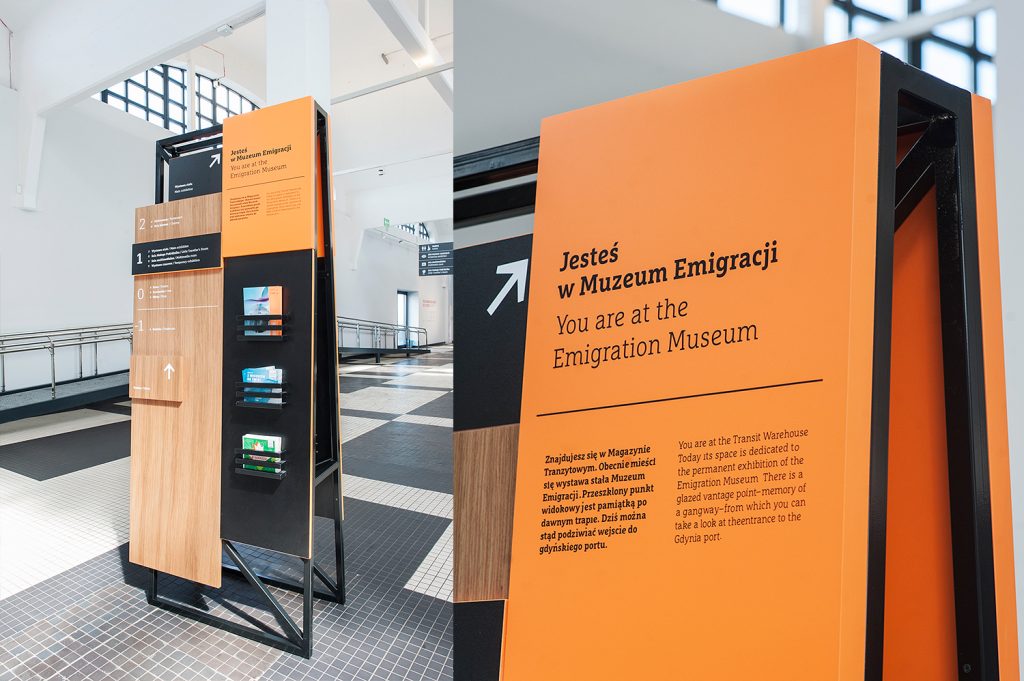
7.1 Importance and Challenges of Museums
Museums, as places for displaying culture, art and history, usually have rich collections and complex exhibition layouts.The presence of a large number of exhibits, exhibition areas and cultural contexts in museums poses many challenges to the design of Wayfinding Signage.Therefore, providing effective navigational guidance in museums is essential to enhance the visitor experience and reduce the rate of getting lost.
7.2 Design Essentials of Wayfinding Signage
The following key points should be considered in the design of Wayfinding Signage in museums:
- Clear and unambiguous directions: Museums usually have multiple exhibition halls, collection areas, public facilities and other important areas, and Wayfinding Signage should provide clear and unambiguous directions to help visitors quickly find where they need to go. Directions should use easy-to-read fonts and clear graphics to ensure that visitors can easily understand and recognize them.
- Planning of guiding paths: Museums often have multiple passages and corridors, and Wayfinding Signage should plan guiding paths appropriately to avoid visitors getting lost or going in the wrong direction. This can be achieved by setting up clear signs, arrows and directional signs. At the same time, the continuity and logic of the guiding path should be ensured so that visitors can go to their destinations smoothly.
- Multi-language support: Considering that museums may receive visitors from different countries and cultural backgrounds, Wayfinding Signage should provide multi-language support. This can be achieved by adding bilingual directions to the signage or providing multilingual versions of maps, for example. Such support can help visitors from different countries to better understand the navigation guidelines.
- Security Considerations: Museums often have high security requirements, and Wayfinding Signage should also take security considerations into account. For example, clear signage can be placed near emergency exits and clear instructions can be provided on escape routes. In addition, security can be improved by adding lighting and monitoring equipment.
7.3 Example Analysis: Wayfinding Signage Design for a Museum
A museum is used as an example for the case study. The museum is a large-scale art and cultural center with several exhibition halls, artwork display areas, libraries and other facilities.In order to improve the navigation efficiency, the museum has set up a series of Wayfinding Signage in each exhibition hall. firstly, a large LED display is set up at the entrance to show the main information and map of the museum. Secondly, hanging signage was installed along the main passageways in the lobby to indicate the orientation and location of each gallery. In addition, signage on the handrail was installed at the stairway to guide visitors to the destinations of the various exhibition halls. Finally, electronic screens and information boards were installed in public areas to provide real-time guided tour information and visiting suggestions. The design of these Wayfinding Signage enabled visitors to quickly find the desired location and provided easy and accurate navigation guidance.
7.4 Evaluation and Suggestions for Improvement
In order to evaluate the effectiveness of Wayfinding Signage in museums, the following aspects can be evaluated:
- User Satisfaction Survey: a questionnaire or interview with visitors to find out their satisfaction and feedback on the Wayfinding Signage design. This can provide important information about the user experience and directions for improvement.
- Error rate statistics: Record the error rate and usage of Wayfinding Signage instructions, such as the number of times they are ignored or misunderstood. This can help identify directions and priorities for improvement.
- User Behavior Analysis: By observing behavioral data such as walking paths and dwell time of viewers when using Wayfinding Signage, it is possible to understand their reactions to and the effectiveness of the navigational guidance. This can provide a reference basis for further design optimization.
- User Feedback Collection: Encourage viewers to proactively provide feedback and suggestions on Wayfinding Signage. This can be done by setting up suggestion boxes, online feedback forms, etc. Such feedback can help identify potential problems and provide opportunities for improvement.
Based on the results of the above assessment, suggestions for improvement can be made accordingly. For example, if it is found that some instructions are not clear and easy to understand, consideration can be given to redesigning or adding more explanations; if it is found that users often ignore or misunderstand some instructions, the user experience can be improved by adjusting the layout or adding additional signs; if it is found that users have a high demand for certain areas but lack corresponding navigation guidelines, corresponding signs and instructions can be added according to the actual situation, and so on.
To summarize, the application of Wayfinding Signage in museums needs to consider factors such as clear instructions, reasonable guide path planning, multi-language support and security. By analyzing and evaluating the actual cases, we can improve the navigation efficiency and user experience in museums.
Chapter 8 Summary and Outlook
8.1 Summary
In this chapter, we have discussed in detail the application of Wayfinding Signage in different places. From shopping malls, airports, hotels to museums, we analyzed the characteristics and challenges of these venues and provided corresponding design points and example analysis. By evaluating user satisfaction, error rate statistics, and user behavior analysis, we can understand the effectiveness of Wayfinding Signage and make suggestions for improvement.
Through the discussion in this chapter, we can draw the following conclusions:
- The design of Wayfinding Signage should consider factors such as clear and unambiguous instructions, reasonable guided path planning, multi-language support, and security.
- In shopping malls, the design of Wayfinding Signage should provide clear and concise instructions to help customers find the desired location quickly. At the same time, it should pay attention to the continuity and logic of the wayfinding path to avoid customers getting lost or going in the wrong direction.
- In airports, Wayfinding Signage should rationally plan the guiding path and provide clear signs and instructions to help travelers smoothly check in, find waiting areas and boarding gates.
- In hotels, Wayfinding Signage should provide accurate location information and navigational guidance to help guests easily find rooms, restaurants, gyms and other facilities.
- In museums, Wayfinding Signage should provide clear and concise instructions to help visitors quickly find exhibits, exhibition areas and cultural context.
- By analyzing real cases and evaluating and improving them, navigation efficiency and user experience can be improved.
8.2 Outlook
As the demand for travel, shopping and entertainment continues to grow, the use of Wayfinding Signage in these venues will become increasingly important. In the future, we can expect the following advances:
- The emergence of more innovative Wayfinding Signage technologies, such as the use of Augmented Reality (AR) and Virtual Reality (VR) technologies to provide a richer, immersive navigation experience.
- Personalized Wayfinding Signage design, tailored to the needs and preferences of different groups of people, to improve user satisfaction and ease of use.
- Integration with other technologies, such as Artificial Intelligence (AI) and the Internet of Things (IoT), to enable smarter navigation guidance systems that provide more accurate information and services.
- More cross-cultural and multi-language support to meet the needs of travelers from different countries and regions.
In short, Wayfinding Signage applications in various fields will continue to evolve and improve, providing better navigation experiences and services. Designers and related practitioners need to pay close attention to the changes in user needs and technology trends, and continue to innovate and improve their design methods and technology tools.
